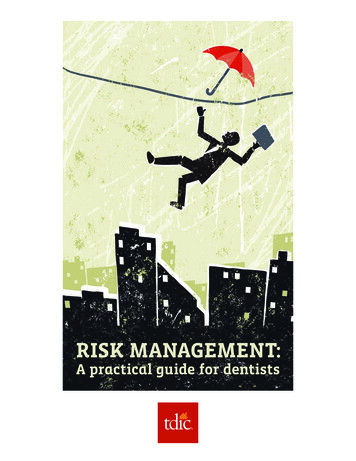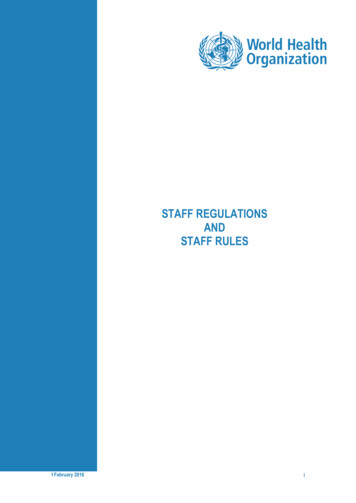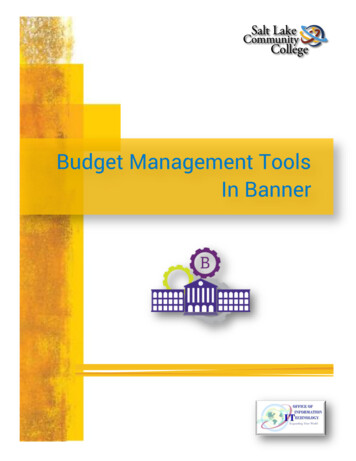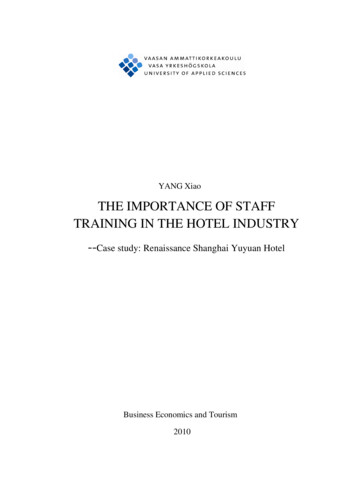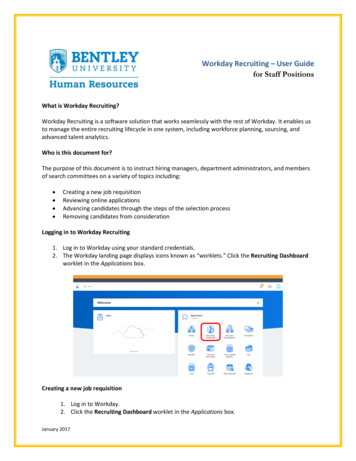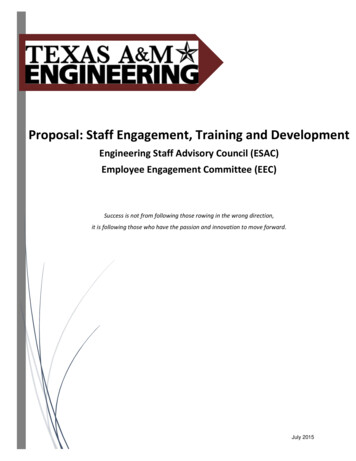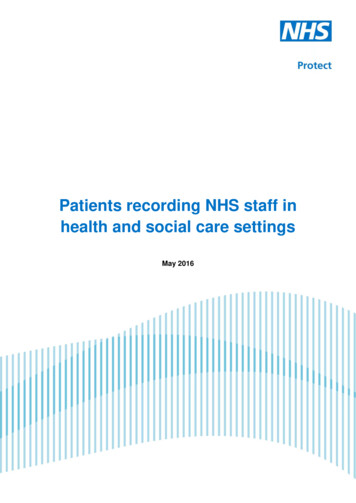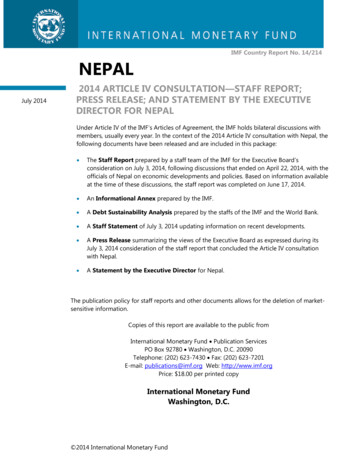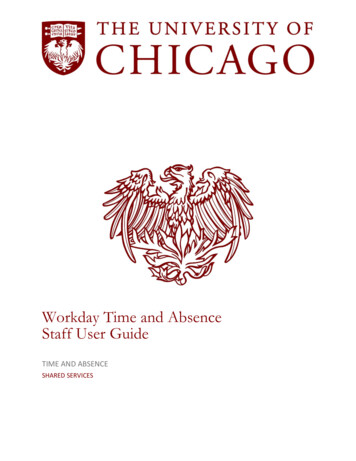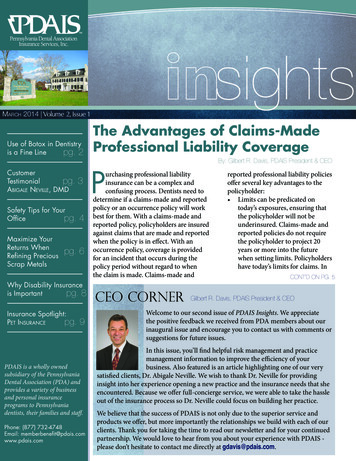
Transcription
sightsMarch 2014 Volume 2, Issue 1Use of Botox in Dentistryis a Fine Linepg. 2CustomerTestimonialpg.Abigale Neville, DMD3Safety Tips for YourOfficepg.4Maximize YourReturns WhenRefining PreciousScrap Metalspg. 6Why Disability Insuranceis Importantpg. 8Insurance Spotlight:Pet Insurancepg.9PDAIS is a wholly ownedsubsidiary of the PennsylvaniaDental Association (PDA) andprovides a variety of businessand personal insuranceprograms to Pennsylvaniadentists, their families and staff.Phone: (877) 732-4748Email: memberbenefit@pdais.comwww.pdais.comThe Advantages of Claims-MadeProfessional Liability CoverageBy: Gilbert R. Davis, PDAIS President & CEOPurchasing professional liabilityinsurance can be a complex andconfusing process. Dentists need todetermine if a claims-made and reportedpolicy or an occurrence policy will workbest for them. With a claims-made andreported policy, policyholders are insuredagainst claims that are made and reportedwhen the policy is in effect. With anoccurrence policy, coverage is providedfor an incident that occurs during thepolicy period without regard to whenthe claim is made. Claims-made andCEO Cornerreported professional liability policiesoffer several key advantages to thepolicyholder: Limits can be predicated ontoday’s exposures, ensuring thatthe policyholder will not beunderinsured. Claims-made andreported policies do not requirethe policyholder to project 20years or more into the futurewhen setting limits. Policyholdershave today’s limits for claims. InCONT’D ON PG. 5Gilbert R. Davis, PDAIS President & CEOWelcome to our second issue of PDAIS Insights. We appreciatethe positive feedback we received from PDA members about ourinaugural issue and encourage you to contact us with comments orsuggestions for future issues.In this issue, you’ll find helpful risk management and practicemanagement information to improve the efficiency of yourbusiness. Also featured is an article highlighting one of our verysatisfied clients, Dr. Abigale Neville. We wish to thank Dr. Neville for providinginsight into her experience opening a new practice and the insurance needs that sheencountered. Because we offer full-concierge service, we were able to take the hassleout of the insurance process so Dr. Neville could focus on building her practice.We believe that the success of PDAIS is not only due to the superior service andproducts we offer, but more importantly the relationships we build with each of ourclients. Thank you for taking the time to read our newsletter and for your continuedpartnership. We would love to hear from you about your experience with PDAIS please don’t hesitate to contact me directly at gdavis@pdais.com.
Use of Botox in Dentistry is a Fine LineAs questions increase about the use of Botox indentistry, The Dentists Insurance Company(TDIC) advises policyholders that the useof preparations such as Botox and Dysport must bewithin the scope of their dental license as defined bythe dental licensing authority in their state.“If doctors are practicing legally within the scopeof their dental license, there is coverage under TDIC’sprofessional liability policy,”said TDIC underwritingdirector Dora Earls. However,Earls noted that if the statedental licensing authoritydetermines that use of Botox orsimilar drugs is not within thescope of dental practice, thereis no TDIC coverage.For example, dentistryin California is defined bythe California Business andProfessions Code section 1625.The dental board lists the pertinent language of thecode as, “diagnosis or treatment, by surgery or othermethod, of diseases and lesions and the correctionof malpositions of the human teeth, alveolar process,gums, jaws or associated structures; and such diagnosisor treatment may include all necessary relatedprocedures as well as the use of drugs, anestheticagents and physical evaluation ” The board states thata dentist may use any legally prescribed drugs to treatpatients as long as the treatment is within this specifiedscope of practice.Additionally, in California, dentists may not useBotox cosmetically without an Elective Facial CosmeticSurgery permit issued by the dental board. Licenseddentists who have completed residencies in oral andmaxillofacial surgery and additional criteria outlinedby the dental board can apply for an Elective Facial22By: TDIC Risk Management StaffCosmetic Surgery permit. There are two categoriesfor these permits. Category I relates to cosmetic facialsurgery, such as contouring of the osteocartilaginousfacial structure, and Category II relates to cosmetic softtissue contouring or rejuvenation. The details of thissystem can be found in the California Business andProfessions Code section 1638.1.The California Dental Board also states, “Somepermit holders may notbe authorized to performall cosmetic surgeryprocedures within thescope of the ElectiveFacial Cosmetic Surgerypermit.” Additionally, thedental board notes that allprocedures authorized underthe Elective Facial CosmeticSurgery permit must beperformed in an acutecare hospital or a certifiedsurgical center as defined in California Business andProfessions Code section 1638.1(f).Botox and Dysport are commercial preparationsof botulinum toxin derived from the bacteriumClostridium botulinum, a nerve “blocker” that bindsto the nerves and prevents the release of acetylcholine,a neurotransmitter. The result is muscle paralysis,according to the National Center for BiotechnologyInformation. Botulinum toxin is approved by theFDA, and its most common use is in applications tominimize fine facial wrinkles.Concerning professional liability coverage andtraining or certification for dentists to use Botox orsimilar drugs, TDIC’s endorsement states, “Beforeperforming the alleged injection(s), you must haveobtained any license, permit, certification or trainingrequired by the state dental licensing authority whereyou practice.” n
Customer TestimonialAbigale Neville, DMDBy: Natalie Kinsinger, PDAIS Marketing ManagerAt PDAIS, we value each and every customer andenjoy hearing feedback regarding our products,services and customer service. Recently, wewere pleased to offer our services to a PDA memberdentist opening a new practice. Dr. Abigale Nevilleof Holland, PA contacted PDAIS after applying fora loan with Bank of America Practice Solutions, aPDA endorsed vendor. While applying for the loan,she learned of several types of insurance she needed.Knowing PDAIS provided insurance to dentists, shegave us a call. What she quickly found out was that notonly could we help her with practice insurance, butany other type of insurance she needed as well. Insteadof having to make dozens of calls to companies andcomparing rates, she only had to make one.“PDAIS was able to offer all of the types ofinsurance I needed, even including constructioninsurance. I also needed disability, business overhead& contents insurance, and I chose to move mymalpractice insurance with them - it just made sense.”Dr. Neville enjoyed working with the PDAIS staffwho took a genuine interest in her practice and howthe building process was going. “PDAIS’s customerservice is excellent. I would get emails and call backsimmediately and updates on the process along theway. And I only had to fill out paperwork once andthat information was then applied to all the differentpolicies, saving me time.”When asked what she would like her colleagues toknow about PDAIS, Dr. Neville said, “PDAIS offerseverything you need and educates you about thedifferent types of insurance and what they cover, whichis especially important for new business owners. And ifyou aren’t crazy about your current insurance provider,give PDAIS a call. There’s a goodchance they can provide youwith better rates.”We are proud to shareDr. Neville’s experience, aswe always aim to providecustomers with top-notchcustomer service andinsurance products atcompetitive rates.To get a free, noobligation quote,visit www.pdais.com/freequotes orcontact us at (877)732-4748. We arehere to assist you,answer your questionsand find ways to saveyou money. nI only had to make one call. PDAIS was ableto offer every type of insurance I needed. Abigale Neville, DMD33
Safety Tips for Your OfficeSlips & falls are a major driver of claims for dental officesBy: Eastern Alliance Insurance Group StaffAs we welcome spring, we know this past winter’sweather was particularly difficult for manyoffices. Employees and patients struggledthrough treacherous roads and delayed or canceledappointments. Parking spaces and sidewalks neededto be cleared—sometimes daily. One thing you cancount on—when the ice and snow comes down, thelikelihood of slips, trips and falls goes up!Did you know that slips and falls are amajor driver of claims for dental offices?Some simple precautions can go a longway toward providing a safe andhealthy work environment for youremployees and your patients. Take the time to find and walkonly on sidewalks or designated walkareas that are free of ice and snow. Do not walk on curbs or median strips. Pay attention to and heed warning signsfor slippery areas and areas to avoid. Avoid short cuts. More short cuts meansgreater chance for injury. Take particular caution at building entrances/exits, where melted snow, ice and anti-skidmaterial can accumulate. After dark, walk in well-lit areas so you canidentify slippery areas and avoid them. Wear proper footwear, such as flat, rubber-soledshoes. Keep salt, cat litter or some form of anti-skidmaterial on hand to spread out in front of you toprovide adequate traction. Ask your staff to immediately inform you of anyice and snow walkway hazards and handle them44immediately.Also be sure to review safe snow removalprocedures with your employees. These precautionscan minimize the potential for workplace injury andmay reduce absenteeism and injuries from snowremoval at home. Using a snowblower? Check the area to be clearedin advance to ensure it is free of debris that couldbe picked-up and hurled by the snow blower,and make sure no one is in the dangerousdischarge area. Never use a snow bloweron a gravel driveway. Read themanufacturer’s manual prior touse. Start and run gas-poweredsnowblowers outside only and neverleave a machine running unattended.Wear hearing protection and avoid loosescarves or other items that could get caught inthe machine. If a snowblower gets clogged, NEVER put yourhand in the intake or discharge chute. Instead,turn the engine off and wait at least 5 secondsfor the blades to stop rotating. Use a long stickor broom handle to clear the clog—NEVERyour hand. Keep all shields in place—DO NOTREMOVE the safety devices on the machine. Using a shovel? Shoveling is an extremelystrenuous activity, especially when snow is wetand heavy. Snow shoveling causes an average ofnearly 100 deaths and 11,500 ER visits each yearin the United States. Check with a doctor beforeyou shovel, listen to your body, and stop if you feelCONTINUED ON PG. 7
CONT’D FROM PG. 1The Advantages of Claims-Made PL Coverage addition, purchasing a claims-made policy can helpeliminate the concern policyholders may have as towhether their previous occurrence carrier remainsin business. If an insurance company wouldgo into receivership (the insurance equivalentof bankruptcy), you can move your coverageto a financially stronger insurance company. Ifthe carrier for an occurrence policy goes intoreceivership, switching to a new financiallystronger carrier will not remedy the problem withthe former carrier.Claims-made and reported policies contain aretroactive date, which indicates when the policy isin force. In many cases, the retroactive date servesas the effective date of the policy period to coverprior acts at NO additional premium. Most claimsmade and reported policies contain a provisionfor free lifetime tail coverage after full retirement,death or disability.With a claims-made policy, the insured can movecoverage from one carrier to another carrier. If youhave an active claims-made policy, you can applyto another insurance company that offers prioracts coverage for claims-made policies. Under thisscenario, the new company takes the retroactivedate from the old policy and endorses it onto thenew policy. The new policy with the retroactivedate from the previous policy now covers thesame period of time as the old policy. Also, thismeans that as long as the new carrier is providingprior acts coverage, there is no need to purchase“extended reported period” (commonly known asthe tail).If a dentist owns an occurrence policy and renewson a claims-made and reported form, the first fewyears of premium can offer SUBSTANTIAL savingsin premium. The claims-made and reportedform does not have to pick up prior acts, as the occurrence form will continue to protect againstincidents that may have occurred during thetime the policy was in effect. This enables manyinsurance carriers to offer discounted premiumson claims-made and reported policies the first fewyears of the policy.From a pricing viewpoint, occurrence policiesare more expensive than comparable claimsmade policies because they provide coverage forincidents that occurred during the policy yearregardless of when the claim is reported. And theoccurrence policy provides a separate limit for eachyear protection is purchased. On average, a dentalprofessional liability policy costs about 10 percentmore a year than a claims-made policy.Claims-made and reported policies give theinsurer the ability to monitor how much moneywill be needed to adjust claims in a particular year,giving them the flexibility to adjust premiumsaccordingly.In years when claims experience is especiallyfavorable, insurers may return excess premiums(those not needed for purposes such as claimsexpenses, operations or capital growth) in the formof policyholder dividends. Insurers offering claimsmade and reported policies can declare dividendsearlier than those that offer occurrence policies.Whether shopping for a new professional liabilityinsurance policy or deciding whether or not torenew an existing one, it’s important to consider theadvantages of a claims-made and reported policybefore making a final decision.For more information or a quote on a professionalliability or claims-made policy, please contact a PDAISrepresentative at (877) 732-4748 or visit the website atwww.pdais.com. n55
Maximize Your Returns When RefiningPrecious Scrap MetalsBy: D-MMEX, a PDA-endorsed vendorCompanies offering cash for gold are abundanton television, online and in print. In thisenvironment, it really pays to do your researchbefore surrendering scrap gold, platinum, silveror palladium to refiners. It’s important to select acompany that will handle your scrap metal returns inan efficient, ethical and professional manner.To give you some ideaof how difficult it can be toproject the value of your scrapprecious metal, consider this.Gold, platinum, palladiumand silver are found in mostdental alloys used in crownconstruction. They alsoinclude some non-preciousalloys, including copper,which are used to bond andfuse the manufactured alloys.A typical gold crown madein the United States can contain anywhere between 40percent and 84 percent gold. You can’t tell by looking.The only way to find out how much gold and othervaluable metals a crown contains is to scientificallyanalyze it.But crowns and bridges are not the only sourceof precious metals in dental settings. You’ll alsofind them in bench grindings that are producedwhen a technician trims a crafted crown to meetthe requirements of the patient. Extractor bags andsweepings contain precious metals that can onlybe refined through incineration. Other sources areplatinum foil used in copings and castings and flashesfrom casting machines — even rugs and carpets thathave been in a dental lab for a long time. An expertprecious metal refiner is able to extract precious metalsfrom all these sources.66Reputable precious metal refiners will tell you whattheir process is. Don’t be afraid to ask. Be sure youget a detailed report of the contents shipped and askwhat percentage of value will be paid on the variousprecious metals. Find out how precious metal pricesare set. Always photograph your precious scrap metalsbefore submitting them forrefining.An endorsed solutionThe Pennsylvania DentalAssociation endorses D-MMEXEasyRefine for its members’precious scrap metal reclamationefforts. The company has alsobeen endorsed by 15 otherstate dental associations ortheir affiliates for good reasons.D-MMEX documents the valueof each shipment and detailshow its valuation and payment process works. The first step in refining is safely transportingthe scrap metal to the refiner. D-MMEXprovides containers that seal and insures theshipment for the dentist. When the scrap is received at the refinery, it ismelted in a crucible (or incinerated) reducingthe metal, porcelain, and biological tissues to amolten substance. The molten substance is formed into a block anda sample drilling is taken and forwarded to anindependent assay office. This scientific methoddetermines the quantity of each precious metalin the sample. Once the analysis is complete, the bar is pricedon the London-based market at the nextCONTINUED ON PG. 7
CONT’D FROM PG. 6Maximize Your Returns When Refiningavailable “fix,” which is the price per ounce foreach precious metal as determined twice dailyby the members of the London Gold Pool. Payment is then made to the dentists forthe value of the four precious metals at theestablished price. DMMEX pays PDA membersa five percent premium on the value of preciousmetals refined. Within 10 business days, the dentist receives acheck and a detailed analysis report showingthe total weight of the material submitted, theamount of non-precious waste and the trueweight and value of the precious metals.It can pay to refine precious metals quarterly orsemi-annually. Keep an eye on the price of gold andsubmit your collected precious scraps for refiningwhen values are stable or trending upward.For more information on the D-MMEX EasyRefine Program, or a free shipping container, contactD-MMEX at (800) 741-3174 or visit www.easyrefine.com and click on “Request Your EasyRefine Kit.” nConfused byHealth CareReform?Help is only one call away. Whether you havequestions regarding how the Affordable Care Act(ACA) applies to your practice, need assistancewith implementation or would like alternativehealth quotes, the PDAIS team is your go-toresource.We are well versed in all aspects of the ACA and areready to assist and guide you through the process.And because you are a valued member of PDA, youhave access to discounted insurance products.Contact us today! It’s the only call youwill have to make to prepare yourself for the healthinsurance changes taking place. Toll free (877) 7324748 or email memberbenefit@pdais.com.We look forward to assisting you!CONT’D FROM PG. 4Safety Tips for Your Officepain. Shovel smaller loads of snow, and push ratherthan lift when possible. Pick the right shovel—asmaller blade lifts less snow, putting less strainon the body, plastic shovels are lighter, andergonomic handles can make the job easier onyour body. Clear snow early and often, takingfrequent breaks.While no article or safety resource can identifyevery unsafe condition or procedure, the precautionsabove can help you build a culture of safety in yourworkplace. If you have specific questions, pleasecontact a PDAIS representative at (877) 732-4748.Remember, spending a little time now thinkingabout safety helps avoid spending a lot of money lateron workers’ compensation premiums. n77
Why Disability Insurance is ImportantHave you ever thought about how you wouldpay your bills if you became sick or injuredand were unable to work? Your chances ofbecoming disabled at some point during your dentalcareer is higher than you may realize. According tothe Social Security Administration, studies showthat a 20-year-old worker has a 3-in-10 ch
By: TDIC Risk Management Staff A s questions increase about the use of Botox in dentistry, The Dentists Insurance Company (TDIC) advises policyholders that the use of preparations such as Botox and D
